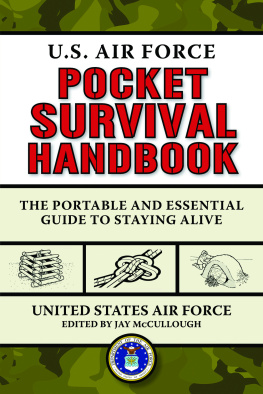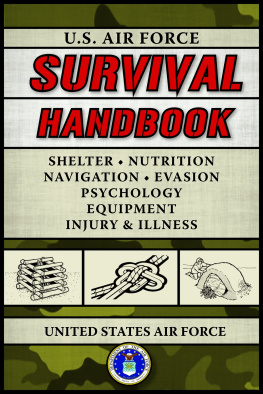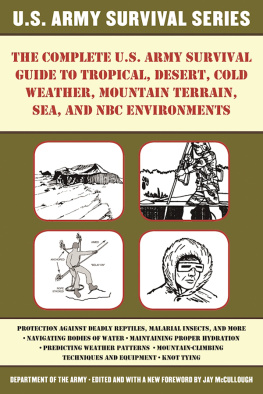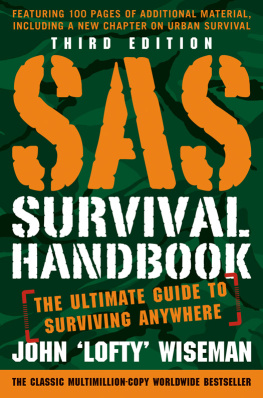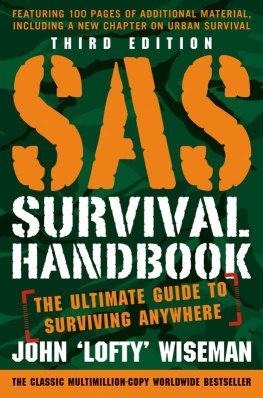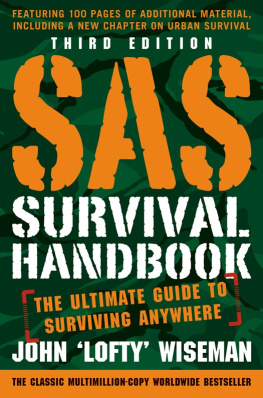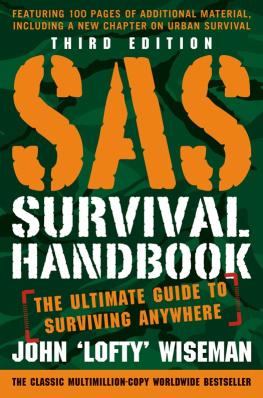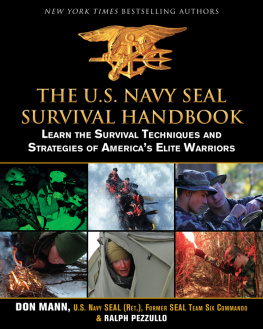U.S. AIR FORCE
POCKET SURVIVAL
HANDBOOK
All Rights Reserved. No part of this book may be reproduced in any manner without the express written consent of the publisher, except in the case of brief excerpts in critical reviews or articles. All inquiries should be addressed to Skyhorse Publishing, 307 West 36th Street, 11th Floor, New York, NY 10018.
Skyhorse Publishing books may be purchased in bulk at special discounts for sales promotion, corporate gifts, fund-raising, or educational purposes. Special editions can also be created to specifications. For details, contact the Special Sales Department, Skyhorse Publishing, 307 West 36th Street, 11th Floor, New York, NY 10018 or info@skyhorsepublishing.com.
Skyhorse and Skyhorse Publishing are registered trademarks of Skyhorse Publishing, Inc., a Delaware corporation.
Library of Congress Cataloging-in-Publication Data is available on file.
DEPARTMENT OF THE AIR FORCE
Headquarters U.S. Air Force
Washington DC 20330-5000 | AF REGULATION 64-4
VOLUME I |
Search and Rescue
SURVIVAL TRAINING
This regulation describes the various environmental conditions affecting human survival, and describes individual activities necessary to enable that survival. This regulation is for instructor and student use in formal and USAF survival and survival continuation training. This regulation also applies to U.S. Air Force Reserve and Air National Guard units and members. Sources used to compile this regulation are listed in the bibliography, attachment 1.
Part One
THE ELEMENTS OF SURVIVING
1-1. Introduction. An ejection sequence, a bailout, or crash landing ends one mission for the crew but starts anotherto successfully return from a survival situation. Are they prepared? Can they handle the new mission, not knowing what it entails? Unfortunately, many aircrew members are not fully aware of their new mission or are not fully prepared to carry it out. All instructors teaching aircrew survival must prepare the aircrew member to face and successfully complete this new mission.
1-2. Aircrew Mission. The moment an aircrew member leaves the aircraft and encounters a survival situation, the assigned mission is to: return to friendly control without giving aid or comfort to the enemy, to return early and in good physical and mental condition.
a. On first impressions, friendly control seems to relate to a combat situation. Even in peacetime, however, the environment may be quite hostile. Imagine parachuting into the arctic when its minus 40 F. Would an aircrew member consider this friendly? No. If the aircraft is forced to crash-land in the desert where temperatures may soar above 120F, would this be agreeable? Hardly. The possibilities for encountering hostile conditions affecting human survival are endless. Crewmembers who egress an aircraft may confront situations difficult to endure.
b. The second segment of the mission, without giving aid or comfort to the enemy, is directly related to a combat environment. This part of the mission may be most effectively fulfilled by following the moral guidethe Code of Conduct. Remember, however, that the Code of Conduct is useful to a survivor at all times and in all situations. Moral obligations apply to the peacetime situation as well as to the wartime situation.
c. The final phase of the mission is to return early and in good physical and mental condition. A key factor in successful completion of this part of the mission may be the will to survive. This will is present, in varying degrees, in all human beings. Although successful survival is based on many factors, those who maintain this important attribute will increase their chance of success.
1-3. Goals. Categorizing this mission into organizational components, the three goals or duties of a survivor are to maintain life, maintain honor, and return. Survival training instructors and formal survival training courses provide training in the skills, knowledge, and attitudes necessary for an aircrew member to successfully perform the fundamental survival duties.
1-4. Survival. Surviving is extremely stressful and difficult. The survivor may be constantly faced with hazardous and difficult situations. The stresses, hardships, and hazards (typical of a survival episode) are caused by the cumulative effects of existing conditions. (See Chapter 2 pertaining to conditions affecting survival.) Maintaining life and honor and returning, regardless of the conditions, may make surviving difficult or unpleasant. The survivors mission forms the basis for identifying and organizing the major needs of a survivor. (See survivors needs in Chapter 3.)
1-5. Decisions. The decisions survivors make and the actions taken in order to survive determine their prognosis for surviving.
1-6. Elements. The three primary elements of the survivors mission are: the conditions affecting survival, the survivors needs, and the means for surviving.
Chapter 2
CONDITIONS AFFECTING SURVIVAL
2-1. Introduction. Five basic conditions affect every survival situation (). These conditions may vary in importance or degree of influence from one situation to another and from individual to individual. At the onset, these conditions can be considered to be neutralbeing neither for nor against the survivorand should be looked upon as neither an advantage nor a disadvantage. The aircrew member may succumb to their effectsor use them to best advantage. These conditions exist in each survival episode, and they will have great bearing on the survivors every need, decision, and action.
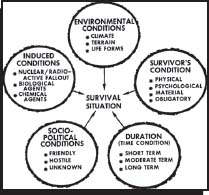
Figure 2-1. Five Basic Conditions.
2-2. Environmental Conditions. Climate, terrain, and life forms are the basic components of all environments. These components can present special problems for the survivor. Each component can be used to the survivors advantage. Knowledge of these conditions may very well contribute to the success of the survival mission.
a. Climate. Temperature, moisture, and wind are the basic climatic elements. Extreme cold or hot temperatures, complicated by moisture (rain, humidity, dew, snow, etc.) or lack of moisture, and the possibility of wind, may have a life threatening impact on the survivors needs, decisions, and actions. The primary concern, resulting from the effects of climate, is the need for personal protection. Climatic conditions also have a significant impact on other aspects of survival (for example, the availability of water and food, the need and ability to travel, recovery capabilities, physical and psychological problems, etc.).
b. Terrain. Mountains, prairies, hills, and lowlands are only a few examples of the infinite variety of landforms which describe terrain. Each of the landforms have a different effect on a survivors needs, decisions, and actions. A survivor may find a combination of several terrain forms in a given situation. The existing terrain will affect the survivors needs and activities in such areas as travel, recovery, sustenance, and, to a lesser extent, personal protection. Depending on its form, terrain may afford security and concealment for an evader; cause travel to be easy or difficult; provide protection from cold, heat, moisture, wind, or make surviving a seemingly impossible task ().

